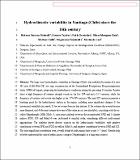Por favor, use este identificador para citar o enlazar a este item:
http://hdl.handle.net/10261/229277COMPARTIR / EXPORTAR:
 SHARE SHARE
 CORE
BASE CORE
BASE
|
|
| Visualizar otros formatos: MARC | Dublin Core | RDF | ORE | MODS | METS | DIDL | DATACITE | |

| Título: | Hydroclimatic variability in Santiago (Chile) since the 16th century |
Autor: | Serrano-Notivoli, Roberto CSIC ORCID ; Tejedor, Ernesto CSIC ORCID; Sarricolea, Pablo; Meseguer‐Ruiz, Oliver; Vuille, Mathias; Fuentealba, Magdalena; Luis, Martín de | Palabras clave: | Tree-ring megadrought SPEI Chile |
Fecha de publicación: | ene-2021 | Editor: | John Wiley & Sons | Citación: | Serrano‐Notivoli R, Tejedor E, Sarricolea P, Meseguer‐Ruiz O, Vuille M, Fuentealba M, Luis M. Hydroclimatic variability in Santiago (Chile) since the 16th century. International Journal of Climatology 41 (S1): E2015-E2030 (2021) | Resumen: | The long‐term hydroclimatic variability in Santiago (Chile) was analysed by means of a new 481‐year (1536–2016 CE) tree‐ring reconstruction of the Standardized Precipitation Evapotranspiration Index (SPEI) of August, integrating the hydroclimatic conditions during the preceding 14 months. Results show a high frequency of extreme drought events in the late 20th and early 21st centuries, while the frequency of extreme wet events was higher in the 17th–18th centuries. The mid‐20th century represents a breaking point for the hydroclimatic history in the region, including some significant changes: (a) the interannual variability increased; (b) the wet events became less intense; (c) the extreme dry events became more frequent; and (d) the most intense dry event of the entire period was identified, coinciding with the so‐called Megadrought (2006–2016). A correlation analysis between the reconstructed SPEI and three climate indices (PDO, SOI and Niño3.4) was performed at monthly scale, considering different multi‐annual aggregations. The analysis shows diverse impacts on the hydroclimatic variability, with positive correlations between SPEI and PDO as well as Niño3.4, and negative correlations between SPEI and SOI. The most significant correlations were, overall, found at multi‐annual time scales (>7 years). Results help to better understand the current hydroclimatic changes (Megadrought) in a long‐term context. | Descripción: | 35 Pags.- 7 Figs.- 4 Tabls. The definitive version is available at: https://rmets.onlinelibrary.wiley.com/journal/10970088 | Versión del editor: | https://doi.org/10.1002/joc.6828 | URI: | http://hdl.handle.net/10261/229277 | DOI: | 10.1002/joc.6828 | ISSN: | 0899-8418 | E-ISSN: | 1097-0088 |
| Aparece en las colecciones: | (EEAD) Artículos |
Ficheros en este ítem:
| Fichero | Descripción | Tamaño | Formato | |
|---|---|---|---|---|
| Serrano-NotivoliR_IntJClimatol_2021.pdf | 18,48 MB | Adobe PDF |  Visualizar/Abrir |
CORE Recommender
SCOPUSTM
Citations
10
checked on 18-abr-2024
WEB OF SCIENCETM
Citations
10
checked on 21-feb-2024
Page view(s)
144
checked on 22-abr-2024
Download(s)
94
checked on 22-abr-2024
Google ScholarTM
Check
Altmetric
Altmetric
NOTA: Los ítems de Digital.CSIC están protegidos por copyright, con todos los derechos reservados, a menos que se indique lo contrario.
